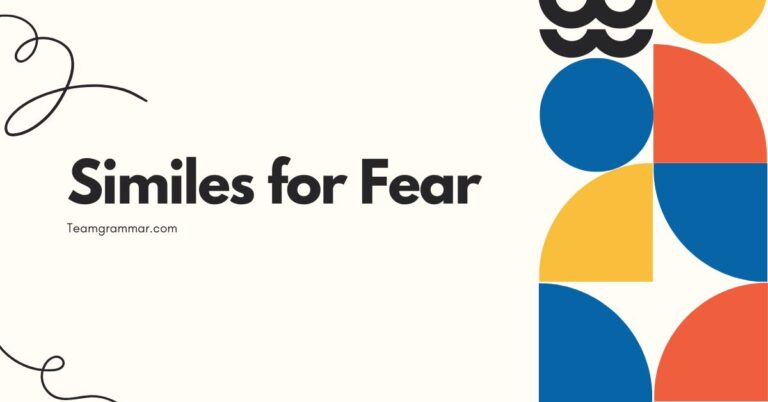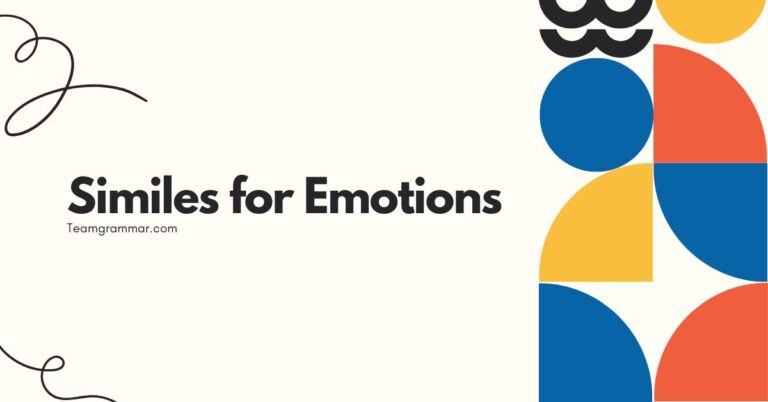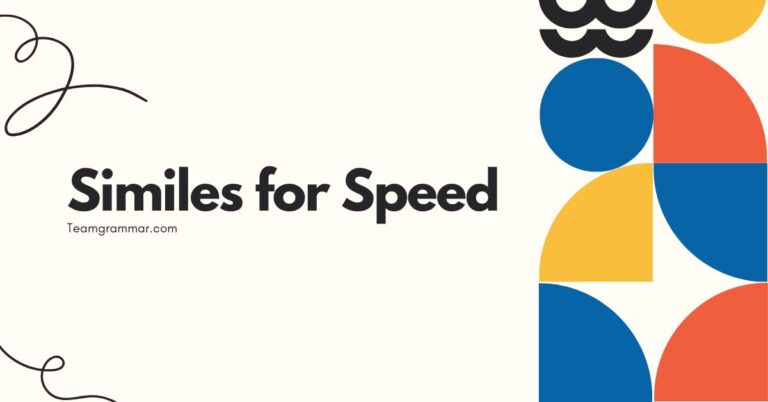39 Similes for Joy: Expressing Happiness with Figurative Language
Joy is a fundamental human emotion, and English offers countless ways to express it. Among the most vivid and engaging techniques is the use of similes.
Similes, by comparing joy to other things, paint a richer, more evocative picture for the reader or listener. Understanding how to craft and use similes effectively can significantly enhance your writing and communication skills.
This article explores the diverse world of similes for joy, providing definitions, examples, usage rules, and practical exercises to help you master this powerful literary tool. This guide is perfect for students, writers, and anyone looking to add color and depth to their expression of happiness and delight.
Table of Contents
- Introduction
- Definition of Simile
- Structural Breakdown of Similes
- Types of Similes for Joy
- Examples of Similes for Joy
- Usage Rules for Similes
- Common Mistakes with Similes
- Practice Exercises
- Advanced Topics in Similes
- Frequently Asked Questions
- Conclusion
Definition of Simile
A simile is a figure of speech that directly compares two different things using the words “like” or “as.” The purpose of a simile is to describe something by likening it to something else, often to make the description more vivid, engaging, or understandable. It is a fundamental tool in figurative language, employed in both literature and everyday conversation to add depth and color to our expressions.
Similes fall under the broader category offigures of speech, which are literary devices used to convey meaning beyond the literal. Similes specifically belong to the subcategory ofcomparisons, where an explicit connection is made between two unlike things.
This contrasts with metaphors, which imply a similarity without using “like” or “as.” The function of a simile is to enhance descriptive power by creating a relatable image in the reader’s mind.
Similes are used in various contexts, from poetry and prose to advertisements and casual conversations. In literature, they can evoke specific emotions, create memorable imagery, and deepen thematic elements.
In everyday speech, similes can make explanations clearer and more engaging. The effectiveness of a simile lies in its ability to draw a creative connection between the subject and the comparison, making the description more impactful and memorable.
Structural Breakdown of Similes
The basic structure of a simile includes three key components: thesubject, thelinking word(either “like” or “as”), and theobject of comparison. The subject is the thing being described, and the object of comparison is what it is being compared to.
The linking word establishes the relationship between the two.
For example, in the simile “He was as happy as a lark,” “He” is the subject, “as” is the linking word, and “a lark” is the object of comparison. The simile suggests that the person’s happiness is similar to the carefree and joyful nature of a lark.
The pattern of a simile is typically:Subject + Linking Word + Object of Comparison. This structure allows for flexibility and creativity in expressing comparisons.
The subject can be a noun, pronoun, or even a clause. The object of comparison can be a noun, noun phrase, or even a more complex image or idea.
The key is that the comparison should be meaningful and contribute to a better understanding or appreciation of the subject.
Variations in the structure can include using different tenses or adding descriptive words. For instance, “She felt like she was floating on a cloud” uses a more complex verb phrase (“felt like she was floating”) but still adheres to the basic simile structure.
Understanding this fundamental structure is crucial for both recognizing and creating effective similes.
Types of Similes for Joy
Similes can be categorized based on the type of imagery or concept they employ. When it comes to expressing joy, similes often draw from nature, animals, abstract concepts, food, and sensory experiences.
Nature-Based Similes
Nature-based similes use elements of the natural world to describe joy. These similes are often evocative and can create a sense of freshness and vitality.
Examples include comparing joy to sunshine, blooming flowers, or a gentle breeze.
Animal-Related Similes
Animal-related similes draw on the characteristics and behaviors of animals to convey joy. These similes can be playful and expressive, comparing joy to the antics of puppies, the song of birds, or the freedom of butterflies.
Abstract Concept Similes
Abstract concept similes compare joy to intangible ideas or feelings. These similes often highlight the depth and intensity of happiness, such as comparing joy to pure bliss, unadulterated freedom, or a sense of perfect peace.
Food-Related Similes
Food-related similes use the pleasure and satisfaction associated with food to describe joy. These similes can be particularly effective in conveying a sense of indulgence and delight, comparing joy to sweet treats, savory delights, or refreshing drinks.
Sensory Similes
Sensory similes engage the senses to evoke the feeling of joy. These similes can focus on sight, sound, smell, taste, or touch, creating a multi-dimensional experience for the reader or listener.
Examples include comparing joy to the sound of laughter, the warmth of a hug, or the sight of a beautiful sunset.
Examples of Similes for Joy
Here are several examples of similes used to express joy, categorized by the type of imagery they employ. Each category provides a diverse range of comparisons to illustrate the versatility of similes.
Nature-Based Similes
Nature provides a rich source of imagery for expressing joy. Natural elements like sunshine, flowers, and landscapes can effectively convey feelings of happiness and contentment.
The following table provides examples of such similes.
| Simile | Explanation |
|---|---|
| She was as happy as a lark singing in the morning. | Compares her happiness to the cheerful song of a lark at dawn. |
| His joy was like sunshine after a long winter. | Suggests that his joy brought warmth and light after a period of hardship. |
| Their laughter was as bright as a field of sunflowers. | Compares their laughter to the vibrant and cheerful appearance of sunflowers. |
| Her smile was as radiant as the morning sun. | Suggests her smile was bright and warming like the sun. |
| He felt as light as a feather floating on the breeze. | Compares his feeling of joy to the effortless movement of a feather in the wind. |
| Their hearts danced like leaves in the autumn wind. | Suggests a joyful and carefree movement, similar to leaves dancing. |
| Her spirit was as free as a bird soaring through the sky. | Compares her spirit to the unconstrained freedom of a bird in flight. |
| His eyes sparkled like stars on a clear night. | Suggests his eyes shone with happiness, similar to the sparkle of stars. |
| Their love blossomed like flowers in the spring. | Compares their love to the growth and beauty of spring flowers. |
| She felt as refreshed as a forest after a rain. | Suggests her feeling of joy was revitalizing, like a forest after rain. |
| His voice was as melodious as a babbling brook. | Compares his voice to the soothing and pleasant sound of a brook. |
| Their joy spread like wildfire through the crowd. | Suggests their joy was infectious and rapidly spread to others. |
| She was as serene as a calm lake at dawn. | Compares her peaceful joy to the tranquility of a lake at dawn. |
| His heart felt like a garden in full bloom. | Suggests his heart was full of life, color, and beauty, like a blooming garden. |
| Their happiness was as boundless as the ocean. | Compares their happiness to the vast and limitless expanse of the ocean. |
| She moved as gracefully as a willow in the wind. | Suggests her movement was fluid and elegant, like a willow tree swaying. |
| His laughter echoed like thunder in the mountains. | Compares his laughter to the powerful and resounding sound of thunder. |
| Their spirits lifted like kites in the sky. | Suggests their spirits rose with joy, similar to kites ascending. |
| She felt as grounded as an ancient oak tree. | Compares her feeling of joy to the stability and strength of an oak tree. |
| His presence was as refreshing as a cool spring. | Suggests his presence brought a revitalizing sense of joy. |
| Their excitement bubbled like a geyser about to erupt. | Compares their excitement to the anticipation of a geyser erupting. |
| She skipped through the park as carefree as a summer breeze. | Suggests her movement was light and untroubled, like a summer breeze. |
Animal-Related Similes
Animals, with their diverse behaviors and characteristics, offer a wide range of comparisons for expressing joy. These similes can be playful, endearing, and vividly descriptive.
The following table provides examples of such similes.
| Simile | Explanation |
|---|---|
| He was as happy as a clam at high tide. | Compares his happiness to the contentment of a clam in a favorable environment. |
| She felt as playful as a kitten chasing a ball of yarn. | Suggests her joy was expressed through playful and energetic behavior. |
| Their laughter sounded like a chorus of chirping birds. | Compares their joyful laughter to the pleasant and harmonious sound of birds. |
| He was as excited as a puppy with a new toy. | Suggests his excitement was exuberant and full of energy. |
| She danced as gracefully as a swan on a lake. | Compares her graceful movements to the elegance of a swan. |
| Their spirits soared like eagles in the sky. | Suggests their spirits rose with joy and freedom, similar to eagles. |
| He felt as content as a cat basking in the sun. | Compares his feeling of contentment to the comfort of a cat in the sun. |
| She was as busy as a bee collecting nectar. | Suggests her joyful activity was purposeful and productive. |
| Their love was as loyal as a dog’s devotion. | Compares their love to the unwavering loyalty of a dog. |
| He felt as lighthearted as a butterfly fluttering in a garden. | Suggests his joy was expressed through light and carefree movements. |
| She was as free as a horse running wild across the plains. | Compares her feeling of freedom to the unconstrained movement of a wild horse. |
| Their enthusiasm was like a pack of wolves howling at the moon. | Suggests their enthusiasm was intense and unified. |
| He felt as strong as an ox after the victory. | Compares his feeling of strength to the power of an ox. |
| She was as gentle as a lamb with the newborn. | Suggests her gentle nature was expressed through caring actions. |
| Their joy multiplied like rabbits in springtime. | Compares their joy to the rapid reproduction of rabbits. |
| He felt as wise as an owl imparting knowledge. | Suggests his feeling of wisdom was expressed through sharing knowledge. |
| She was as quick as a fox when she found the solution. | Compares her quick thinking to the cunning of a fox. |
| Their laughter echoed like the trumpeting of elephants. | Suggests their laughter was loud and memorable. |
| He felt as graceful as a gazelle leaping through the savanna. | Compares his graceful movements to the agility of a gazelle. |
| She was as radiant as a peacock displaying its feathers. | Suggests her radiant joy was expressed through her appearance. |
| Their spirits were as resilient as a salmon swimming upstream. | Compares their resilience to the determination of a salmon. |
Abstract Concept Similes
Abstract concepts can provide powerful comparisons for expressing joy, often highlighting the depth and intensity of the emotion. These similes can evoke a sense of profound happiness and contentment.
The following table provides examples of such similes.
| Simile | Explanation |
|---|---|
| She felt as light as a cloud after hearing the good news. | Compares her feeling to the lightness of a cloud, suggesting a burden has been lifted. |
| His joy was like a wave of pure bliss washing over him. | Suggests his joy was overwhelming and all-encompassing. |
| Their happiness was as strong as an unbreakable bond. | Compares their happiness to the strength and permanence of a strong bond. |
| He felt as free as a bird released from its cage. | Suggests his joy came from a newfound sense of freedom. |
| She was as peaceful as a quiet meditation. | Compares her joy to the tranquility and serenity of meditation. |
| Their spirits were as high as the sky after winning the game. | Suggests their spirits were elevated with joy and excitement. |
| He felt as content as a king on his throne. | Compares his feeling of contentment to the satisfaction of a ruler. |
| She was as radiant as a beacon of hope. | Suggests her joy was a source of inspiration and positivity. |
| Their love was as deep as the ocean. | Compares their love to the vast and profound depth of the ocean. |
| He felt as powerful as a superhero saving the world. | Suggests his joy came from a sense of accomplishment and strength. |
| She was as grateful as a child receiving a gift. | Compares her feeling of gratitude to the pure joy of a child. |
| Their laughter was like music to his ears. | Suggests their laughter brought immense pleasure and joy. |
| He felt as rejuvenated as a phoenix rising from the ashes. | Compares his feeling of renewal to the mythical rebirth of a phoenix. |
| She was as confident as a lion ready to roar. | Suggests her joy was expressed through a sense of self-assurance. |
| Their spirits were as light as air after the celebration. | Compares their spirits to the weightlessness of air, suggesting carefree joy. |
| He felt as serene as a monk in deep meditation. | Suggests his joy came from a state of inner peace and tranquility. |
| She was as inspired as an artist holding a paintbrush. | Compares her feeling of inspiration to the creative energy of an artist. |
| Their joy was as contagious as a yawn in a crowded room. | Suggests their joy quickly spread to others around them. |
| He felt as blessed as a saint receiving grace. | Compares his feeling of joy to the spiritual fulfillment of a saint. |
| She was as uplifted as a balloon rising to the sky. | Suggests her joy came from a sense of elevation and freedom. |
| Their happiness was as timeless as a classic melody. | Compares their happiness to something enduring and universally appreciated. |
Food-Related Similes
Food-related similes can effectively convey joy by drawing on the pleasure and satisfaction associated with eating. These similes often create a sense of indulgence and delight.
The following table provides examples of such similes.
| Simile | Explanation |
|---|---|
| Her laughter was as sweet as honey. | Compares her laughter to the pleasant taste of honey, suggesting it was delightful. |
| His joy was like a warm cup of cocoa on a cold day. | Suggests his joy brought comfort and warmth. |
| Their happiness was as rich as chocolate cake. | Compares their happiness to the indulgent and satisfying taste of chocolate cake. |
| He felt as refreshed as a cool glass of lemonade. | Suggests his joy was revitalizing and thirst-quenching. |
| She was as bubbly as champagne celebrating a victory. | Compares her joyful enthusiasm to the effervescence of champagne. |
| Their spirits were as light as cotton candy at a carnival. | Suggests their spirits were light and carefree. |
| He felt as satisfied as after a Thanksgiving feast. | Compares his feeling of satisfaction to the contentment after a large meal. |
| She was as bright as a lollipop in a candy store. | Suggests her joy was vibrant and eye-catching. |
| Their love was as spicy as a jalapeño, adding zest to life. | Compares their love to the bold and exciting taste of a jalapeño. |
| He felt as energized as after a strong cup of coffee. | Suggests his joy brought a boost of energy and alertness. |
| She was as smooth as butter, gliding through the party. | Compares her graceful movements to the smooth texture of butter. |
| Their laughter was like a fine wine, getting better with age. | Suggests their laughter was refined and appreciated over time. |
| He felt as nourished as after a hearty, home-cooked meal. | Compares his feeling of well-being to the satisfaction after a wholesome meal. |
| She was as crisp as an apple on a fall day. | Suggests her joy was fresh and invigorating. |
| Their spirits were as sweet as sugar cookies during the holidays. | Compares their spirits to the comforting sweetness of sugar cookies. |
| He felt as invigorated as after drinking green smoothie. | Suggests his joy came from the revitalizing effects of green smoothie. |
| She was as comforting as a bowl of warm oatmeal. | Compares her joy to the soothing comfort of oatmeal. |
| Their happiness was like a perfectly ripe peach. | Suggests their happiness was at its peak and most enjoyable. |
| He felt as delighted as a child with a birthday cake. | Compares his feeling of delight to the pure joy of a child. |
| She was as refreshing as a sip of sparkling water. | Suggests her joy was clean and invigorating. |
Sensory Similes
Sensory similes engage the senses to evoke the feeling of joy, creating a multi-dimensional experience for the reader or listener. These similes can focus on sight, sound, smell, taste, or touch.
The following table provides examples of such similes.
| Simile | Explanation |
|---|---|
| Her laughter sounded like wind chimes in a gentle breeze. | Compares her laughter to the pleasant and delicate sound of wind chimes. |
| His joy felt like a warm hug on a cold day. | Suggests his joy brought comfort and warmth through the sense of touch. |
| Their happiness smelled like freshly baked bread. | Compares their happiness to the comforting and inviting smell of bread. |
| He felt as light as a whisper on the wind. | Suggests his joy was subtle and gentle through the sense of sound. |
| She was as vibrant as a rainbow after a storm. | Compares her joy to the colorful and uplifting sight of a rainbow. |
| Their spirits were as smooth as silk against the skin. | Suggests their spirits brought a sense of luxury and comfort through touch. |
| He felt as clear as a bell ringing through the air. | Compares his feeling of clarity to the distinct and pure sound of a bell. |
| She was as bright as a spotlight shining on a stage. | Suggests her joy was prominent and captivating through sight. |
| Their love was as warm as sunshine on their faces. | Compares their love to the comforting warmth of sunshine through touch. |
| He felt as soft as a cloud drifting in the sky. | Suggests his joy was gentle and comforting through the sense of touch. |
| She was as fragrant as a bouquet of fresh flowers. | Compares her joy to the pleasing scent of flowers. |
| Their laughter was like a symphony filling the room. | Suggests their laughter was harmonious and grand through the sense of sound. |
| He felt as sharp as a pin after a good night’s sleep. | Compares his feeling of alertness to the sensation of sharpness. |
| She was as colorful as a painting in a gallery. | Suggests her joy was visually stimulating and beautiful. |
| Their happiness was as tingly as the bubbles in soda. | Compares their happiness to the exciting sensation of bubbles. |
| He felt as grounded as the earth beneath his feet. | Suggests his joy came from a sense of stability and connection. |
| She was as radiant as a diamond sparkling in the light. | Compares her joy to the brilliant sparkle of a diamond. |
| Their love was as deep as a well, cool and refreshing. | Compares their love to the satisfying feeling of cool water. |
| He felt as invigorated as a plunge into cold water. | Suggests his joy brought a sudden burst of energy and alertness. |
| She was as melodious as a songbird in the forest. | Compares her voice to the pleasant and harmonious sound of a songbird. |
Usage Rules for Similes
Using similes effectively involves understanding certain rules to ensure clarity and impact. The most important rule is that the two things being compared should be distinctly different but share a common characteristic.
The comparison should also enhance the reader’s understanding or appreciation of the subject.
Avoid clichéd similes, which are overused and have lost their impact. Instead, strive for originality and creativity in your comparisons.
For example, instead of saying “as happy as a clam,” try “as content as a clam buried deep in the sand, safe from the tide.”
Ensure that the simile is logical and makes sense in the context. The comparison should be relatable and easy for the reader to understand.
If the comparison is too obscure or far-fetched, it may confuse or distract the reader.
Pay attention to the tone and mood of your writing when using similes. The simile should complement the overall tone and mood, enhancing the desired effect.
A lighthearted simile may not be appropriate in a serious or somber context, and vice versa.
Use similes sparingly to maintain their impact. Overusing similes can make your writing feel contrived and unnatural.
Use them strategically to highlight key descriptions or emotions.
Common Mistakes with Similes
One common mistake is confusing similes with metaphors. Remember that similes use “like” or “as” to make a direct comparison, while metaphors imply a comparison without these words.
For example:
- Incorrect (Metaphor as Simile): Her laughter was a song.
- Correct (Simile): Her laughter was like a song.
Another mistake is creating illogical or nonsensical comparisons. The two things being compared should have a clear and understandable connection.
For example:
- Incorrect: He was as happy as a rock. (Rocks are not typically associated with happiness.)
- Correct: He was as happy as a child on Christmas morning.
Using clichéd similes is another common error. While they may be familiar, they often lack originality and impact.
For example:
- Cliché: As happy as a clam.
- Improved: As happy as a clam safe in its shell, undisturbed by the world.
Finally, using similes excessively can make your writing feel forced and unnatural. Use them sparingly to enhance your descriptions, not to clutter your sentences.
Practice Exercises
Test your understanding of similes with these practice exercises. Each exercise focuses on different aspects of simile usage.
Exercise 1: Identifying Similes
Identify the similes in the following sentences:
| Question | Answer |
|---|---|
| 1. Her voice was as smooth as silk. | Her voice was as smooth as silk. |
| 2. The moon was a silver coin in the sky. | No simile. This is a metaphor. |
| 3. He ran as fast as the wind. | He ran as fast as the wind. |
| 4. Life is a journey. | No simile. This is a metaphor. |
| 5. She felt like she was walking on air. | She felt like she was walking on air. |
| 6. The news hit him like a ton of bricks. | The news hit him like a ton of bricks. |
| 7. Time is money. | No simile. This is a metaphor. |
| 8. The children were as quiet as mice. | The children were as quiet as mice. |
| 9. He is a lion in battle. | No simile. This is a metaphor. |
| 10. She shone like the sun. | She shone like the sun. |
Exercise 2: Completing Similes
Complete the following similes with an appropriate comparison:
| Question | Answer |
|---|---|
| 1. He was as brave as ____. | He was as brave as a lion. |
| 2. She sings like ____. | She sings like an angel. |
| 3. The snow was as white as ____. | The snow was as white as cotton. |
| 4. They fought like ____. | They fought like cats and dogs. |
| 5. The car was as old as ____. | The car was as old as the hills. |
| 6. The party was as lively as ____. | The party was as lively as a carnival. |
| 7. The secret was as safe as ____. | The secret was as safe as a vault. |
| 8. The night was as dark as ____. | The night was as dark as pitch. |
| 9. Her smile was as warm as ____. | Her smile was as warm as sunshine. |
| 10. The answer was as clear as ____. | The answer was as clear as day. |
Exercise 3: Creating Similes
Create similes to describe the following:
| Question | Answer |
|---|---|
| 1. A peaceful morning | The morning was as peaceful as a sleeping baby. |
| 2. A difficult challenge | The challenge was like climbing Mount Everest. |
| 3. A kind person | He was as kind as a loving grandfather. |
| 4. A beautiful sunset | The sunset was like a painting in the sky. |
| 5. A funny joke | The joke was as funny as a clown’s antics. |
| 6. A cold winter day | The day was as cold as ice. |
| 7. A crowded city street | The street was like a river of people. |
| 8. A scary movie | The movie was as scary as a nightmare. |
| 9. A delicious meal | The meal was like a taste of heaven. |
| 10. A long journey | The journey was as long as a lifetime. |
Advanced Topics in Similes
For advanced learners, exploring more nuanced aspects of similes can enhance their writing skills. This includes understanding the use of extended similes, which are longer and more detailed comparisons that can span multiple sentences or even paragraphs.
Additionally, exploring the cultural and historical context of similes can provide deeper insights into their meaning and impact.
Analyzing the works of accomplished writers can reveal how similes are used to create complex imagery, evoke specific emotions, and develop thematic elements. Experimenting with unconventional and unexpected comparisons can also lead to more original and impactful similes.
Furthermore, understanding the subtle differences between similes and other figures of speech, such as analogies and allegories, can help writers choose the most effective tool for their specific purpose. Exploring these advanced topics can elevate your use of similes from a basic descriptive technique to a powerful literary device.
Frequently Asked Questions
- What is the difference between a simile and a metaphor?
A simile makes a direct comparison using “like” or “as,” while a metaphor implies a comparison without using these words. For example, “He is like a lion” is a simile, while “He is a lion” is a metaphor. Similes are more explicit, while metaphors are more suggestive.
- Can a simile be too long?
Yes, a simile can be too long if it becomes overly detailed or distracts from the main point. While extended similes can be effective, they should be used judiciously and with a clear purpose. The length of a simile should be appropriate to the context and the desired effect.
- How can I avoid using clichéd similes?
To avoid clichéd similes, strive for originality and creativity in your comparisons. Think beyond the obvious and
strive for originality and creativity in your comparisons. Think beyond the obvious and look for unique and unexpected connections between the subject and the object of comparison. Consider the specific qualities you want to emphasize and choose comparisons that highlight those qualities in a fresh and engaging way.
- Is it okay to mix similes and metaphors in the same piece of writing?
Yes, it is perfectly acceptable to mix similes and metaphors in the same piece of writing, as long as each figure of speech is used effectively and contributes to the overall meaning and tone. Mixing different types of figurative language can add variety and depth to your writing.
- How do I know if my simile is effective?
An effective simile should enhance the reader’s understanding or appreciation of the subject by creating a vivid and relatable image in their mind. It should be logical, clear, and appropriate to the context. If the simile feels forced, confusing, or clichéd, it may not be effective. Consider the impact of the simile on your target audience and revise accordingly.
Conclusion
Similes are a powerful tool for expressing joy and enhancing your writing with vivid and engaging descriptions. By understanding the definition, structure, types, and usage rules of similes, you can effectively employ them to create memorable imagery and evoke specific emotions.
Avoiding common mistakes and practicing regularly will further refine your skills, allowing you to craft original and impactful comparisons. Whether you are a student, writer, or simply someone who enjoys language, mastering the art of similes will undoubtedly enrich your ability to express the multifaceted emotion of joy.







